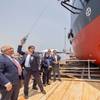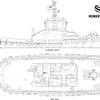Shipbuilding R&D Supported
Project: A Lean Enterprise Model for U.S. Ship Construction, Overhaul, & Repair
Participants: Atlantic Marine Holding Co., Todd Pacific Shipyards, Bath Iron Works, Puget Sound Naval Shipyard, and five others.
Funding: 3.8M NSRP ASE, $3.8M industry cost share.
Description: The principal objective of this project is to complete a comprehensive model for the application of lean manufacturing concepts to multiple market segments of the U.S. shipbuilding and repair industry. The enterprise-wide model will address lean design, materials, and manufacturing practices. It is anticipated that this model will result in a 20+ percent improvement in overall productivity within 36 months. The project focuses on implementation of world-class shipbuilding and lean enterprise practices in seven U.S. shipyards covering four key market segments with the scope of full or partial implementation in the participating shipyards.
Project: Development and Commercialization of Laser Assisted Oxygen Cutting
Participants: Bender Shipbuilding and Repair, Caterpillar, BOC Gases, Alabama Laser, and Electric Boat.
Funding: $672K NSRP ASE, $672K industry cost share.
Description: The project team will develop and exploit an experimental technology for laser assisted oxygen cutting of thick section (> .25-inch) steel plates which is currently in a laboratory stage of development at BOC Gases. The technology will greatly enhance U.S. shipbuilders' ability to accurately and cleanly cut thick-section steel, possibly greater than 100 mm, without increasing laser power output beyond 6kW.
The potential exists for clean and accurate cut edges in both a square and bevel configuration, with minimal secondary part processing after removal from the laser-burning table. The project will provide near term benefits to both Bender Shipbuilding and Repair and Electric Boat, with both cost and quality improvements in ship and submarine construction. Through commercialization and technology transfer, the project will also provide additional impetus for other U.S. shipbuilders to invest in laser-cutting technology, which has demonstrated significant benefits at Bender Shipbuilding and Repair.
Project: Harvest: Finishing the Ship Product Models
Participants: STEP Tools, Electric Boat, and Product Data Services.
Funding: $318K NSRP ASE, $376 industry cost share.
Description: The Harvest project seeks to complete the international standardization of the shipbuilding STEP Application Protocols: AP-218 (Ship Structures), AP-216 (Ship Molded Forms), and AP-215 (Ship Arrangements). This entails the working groups and the editing of the standards documents. Completion of the STEP Shipbuilding Application Protocols will allow the U.S. shipbuilding industry (and the Navy) to "harvest" the investment it has made in the development of product models for ships. In the final rounds of approval, the primary goal is to ensure the viability and completeness of the standard. This includes validation of information requirements, implementation considerations and harmonization with other STEP and related standards. These models will give the shipbuilding industries new options for collaboration, for transferring data between different systems and different versions of the same system, and for managing data across the product life cycle.
Project: Enhancement of Evolution of STEP Participants: Kvaerner Philadelphia Shipyard and Sener Funding: $390K NSRP ASE, $398K industry cost share.
Description: The objective of this proposal is to broaden industry participation in the ongoing Evolution of STEP (ESTEP) task of the ISE project.
Specifically, this project would provide commercial translators for another CAD vendor (Sener and their FORAN product) for the three primary shipbuilding application protocols (structures, piping, and hull forms). FORAN is used by Atlantic Marine Holding Co., Friede Goldman Halter, and Kvaerner Philadelphia at the current time. The problem being addressed by ESTEP is the capability to transfer data from one ship product model to another (CAD-to-CAD Interoperability). ESTEP will help enable shipyards with different ship design programs to exchange information easily and quickly.













